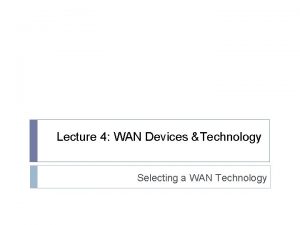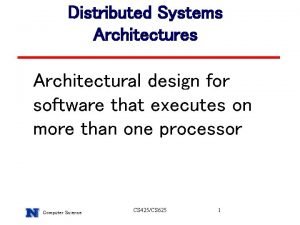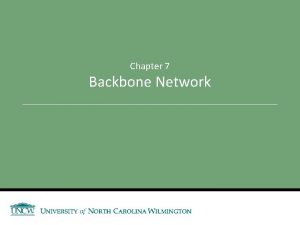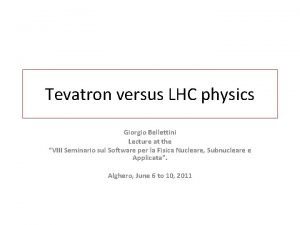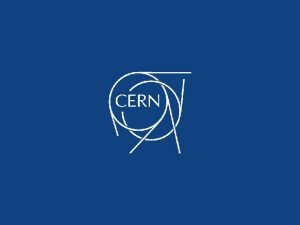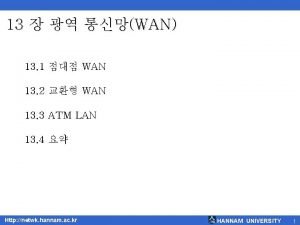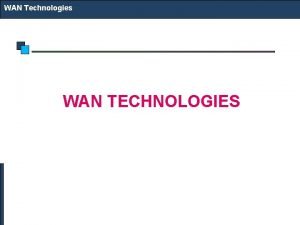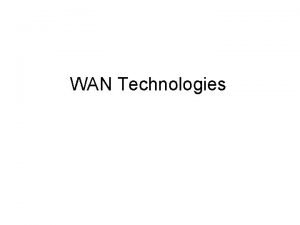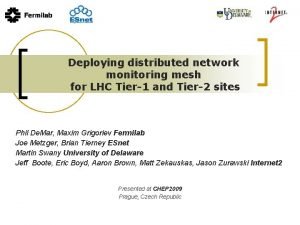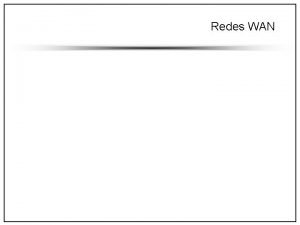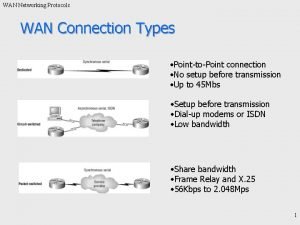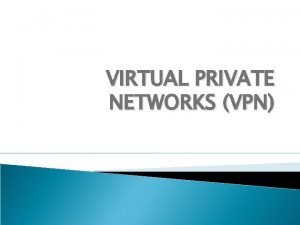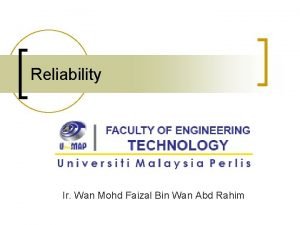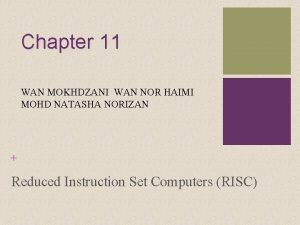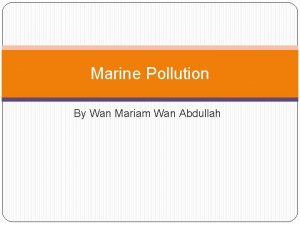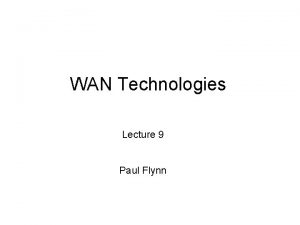US LHC Tier1 WAN Data Movement Security Architectures
























- Slides: 24

US LHC Tier-1 WAN Data Movement Security Architectures Phil De. Mar (FNAL); Scott Bradley (BNL) demar@fnal. gov; bradley@bnl. gov CHEP 2013 October 17, 2013

The Challenges with High Impact Data Movement • Network Bandwidth: § • Site Perimeter Security Obstacles: § • Don’t want this to be your users audio/video apps Optimal performance may require use of alternate network paths § 2 Firewall performance isn’t keeping up Intermingling Bulk Data Traffic with Interactive Applications: § • General R&E networks may not provide enough Means using non-default routing mechanisms

Long Term Trend Toward Isolating Wide -Area Science Data Movement • At Tier-1 Centers, LHC WAN data dwarfs everything else: • • Hybrid R&E Networks to service high impact science data: • • • 3 Isolated network paths Potentially with B/W guarantees Data circuit technologies enable virtual pt-to-pt connections • • (Final year of Tevatron operations) More secure “private” network paths Discipline-specific networks appear ESnet 4 circa 2009

ESnet-Developed Model for a Prototype Site Science DMZ • General idea: separate science data from general campus network infrastructure • Components: § Data Transfer Node (DTN): ® § § Bypass routing around site firewalls Network measurement infrastructure ® • 4 Optimized for WAN transfers Perf. SONAR An architecture, not implementation ESnet prototype Science DMZ figure

Prototype Science DMZ Data Paths • Custom WAN path(s) for science DMZ systems: § § • • Appropriate bandwidth provisioning is primary goal Optimizing latency isn’t a goal Specific security policies & tools for science data traffic Science DMZ resides outside of site perimeter ESnet figure on Science DMZ data paths 5

Diverse Set of LHC WAN Paths Controlled-access traffic reduces security risks • LHC Optical Private Network (LHCOPN) for T 0 <-> T 1 data • • • LHC Open Network Exchange (LHCONE) for T 1/T 2 <-> T 1/T 2 • • LHCOPN Sometimes over private links Sometimes over R&E networks Routed IP path over general R&E network infrastructure • 6 Loosely-controlled access Mix of routed & end-to-end traffic End-to-end circuits: • • Tightly-controlled access Dedicated bandwidth When no other paths are available LHCONE

Policy-Based Routing (PBR) • PBR = forwarding of specific packets based on administrative decision or policy: • • • Cisco implementation is Route-Map command: • • • Up to 5 -tuple mapping (src/dest IP, src/dest port, protocol) Basic components are “mapping” & “action taken if matched” Similar capabilities available from other vendors • 7 In contrast to following normal (dynamic…) routing tables Manually configured on routers Generic name = ACL-based forwarding

IPSLA & Object Tracking • PBR is a form of static routing: • • Potential for black-holing traffic is path is down IPSLA and Object Tracking can be used to avoid black -holing • IPSLA continuously checks to make sure path is up: • • • Object Tracking maintains status of path as an object • • If IPSLA fails, object (path) is marked as down Route-maps (PBR) configured with tracking object identifier • 8 ICMP ping to remote end of path Also used for SNMP monitoring of status for end-to-end circuits If object is down, PBR forwarding is not implemented

FNAL Implementation 9 <Standard Footer>

Site Perimeter Basics at FNAL • FNAL does not have a site firewall • • • Site security based on wide spectrum of controls • • • OK, we have one but science data systems aren’t behind it Firewalls aren’t a factor for our science data movement Strong authentication mandated Onus on sysadmins to secure their systems Intense vulnerability scanning Perimeter controls (ACLs), IPS, web proxy, etc By default, science data must pass thru perimeter controls • Bypass exception: “Known traffic from well-managed systems at trusted sites” • Exception based on risk analysis and acceptable residual risk

FNAL’s PBR Implementation • Forwards science traffic to alternate network paths • 2 -tuple, based on src/dest netblocks • • • All FNAL PBR is internal: • • CMS Tier 1 is always one netblock Remote T 0/T 1/T 2 netblock is always the other No PBR forwarding into WAN Perimeter security control mechanism for bypass traffic: • Only PBR-validated traffic can use the bypass route

FNAL Network Perimeter versus the Science DMZ Model • CMS Tier-1 integrated into campus network: § § • Separate border router for bypass traffic: § • No special DTN nodes Tier-1 d. Cache servers are equivalent to DTNs Consistent with bypass traffic security policy Non-bypass traffic to/from Tier-1 passes through normal perimeter security controls

US-CMS Tier-1 – Alternate WAN Paths • US-CMS Tier-1: • ~1600 systems • Distributed across 4 computer rooms d. Cache servers distributed as well • • Primary & secondary Tier-1 LAN switches • • Connections to campus core Also to bypass perimeter router (E 2 E) for WAN science data • Higher bandwidth connection for science data movement

By Default, Tier-1 Traffic Follows General IP (Routed) Path • Tier-1 WAN traffic forwarded through primary Tier-1 switch • • • Path symmetry more important than traffic load balancing Layer -2 traffic within LAN distributed across links via VPC Unless bypass routed, traffic will pass through campus core & border router • This includes perimeter security controls

Alternate Network Paths via PBR • PBR steers select traffic to/from bypass router • • Based on src/dst address blocks Our Tier-1 netblock is always one of the tuples • • Remote Tier-0, Tier-1, or Tier-2 is the other PBR is manually configured: • • A bit of a pain, but scalable to level of CMS collaboration Dealing with address changes at remote sites also an issue

Non-PBR Traffic on Bypass Connections • Incoming traffic not in PBR tables forwarded to border router: § § § Still gets into the Tier 1 But passes through security controls Also creates WAN path asymmetry ® • We monitor flow data between bypass and border router for this type of traffic § § 16 May cause firewall problem on remote end Will add to PBR tables if its valid CMS traffic But this is still a manual process <Standard Footer>

FNAL Future Directions – Perimeter Architecture • Costs of 100 GE will necessitate consolidating bypass router functions into border & backup border routers: • 17 Consistent with general technology trend to consolidate network hardware & virtualize network functions <Standard Footer>

BNL Implementation 18 <Standard Footer>

BNL Science DMZ • 100 gb/sec WAN Connectivity: • Provides native 100 gb/sec. interfaces • Will interface to Testing and Production 100 g waves Supports multiple 10 gb/sec. and 40 gb/sec. connections Initially 2 attachment ports at 100 gb/sec. Dedicated CIDR block for IP addressing Will have limited Etherchannel to BNL campus Dedicated routing platform – Juniper MX 2010 • • •

BNL Science DMZ cont • Current Status • First 100 g wave in testing phase • Will participate in TA 100 testing with CERN Currently evaluating an Arista 7508 E switch for aggregation, others to follow • • High port density and types are key requirements

BNL Science DMZ Topology Dedicated SCI DMZ Router Aggregation Switch

General Future Directions - Open. Flow • PBR has worked very well to isolate & control our science data traffic, but: • • Manual configuration is a pain Adds complexity to site routing & troubleshooting Keeping up with address changes/additions is difficult Open. Flow - emerging standard for flow-based forwarding: • • PBR is essentially flow-based forwarding, too We’re investigating Open. Flow to replace current PBR • • 22 Long term vision - end-to-end forwarding based on Open. Flow Short term goal - replace PBR within the US-CMS Tier-1 <Standard Footer>

Summary • Separating science data movement from general network traffic has worked well at US-LHC Tier-1 s • • Enabled us to meet needs of both LHC stakeholders & general users, but not at each other’s expense Science DMZ architectures based around PBR for LHC traffic: • • Our implementations work well for us because: • • Avoids performance issues with overloading perimeter security tools We are dealing with established traffic characteristics Our stakeholders are well-organized & long-lived May not translate well to other disciplines Looking toward Open. Flow as a more standard approach to separate out our science data movement

? Questions 24 <Standard Footer>
 Private wan technologies
Private wan technologies Private secruity
Private secruity Integral product architecture example
Integral product architecture example Database and storage architectures
Database and storage architectures Ansi/sparc
Ansi/sparc Network backbone
Network backbone Autoencoders, unsupervised learning, and deep architectures
Autoencoders, unsupervised learning, and deep architectures Theo schlossnagle
Theo schlossnagle Fundamental and incidental interactions
Fundamental and incidental interactions Gui architectures
Gui architectures Database system architectures
Database system architectures Cdn architectures
Cdn architectures Aaron bannert
Aaron bannert Holap in data warehouse
Holap in data warehouse Types of instruction set architecture
Types of instruction set architecture Client server
Client server Banking system architecture diagram
Banking system architecture diagram Backbone network architectures
Backbone network architectures Cache coherence for gpu architectures
Cache coherence for gpu architectures Why systolic architectures
Why systolic architectures Control tower light signals
Control tower light signals Axial locomotor
Axial locomotor Bellettini
Bellettini Lhc baton rouge
Lhc baton rouge Hl-lhc schedule
Hl-lhc schedule
